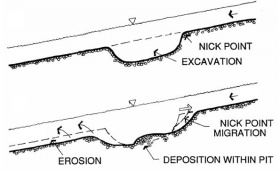Difference between revisions of "Reduce impact of dredging"
(→Reduce impact of dredging) |
(→General description) |
||
| Line 11: | Line 11: | ||
As a consequence, mining results in the loss or impoverishment of aquatic and riparian habitats. | As a consequence, mining results in the loss or impoverishment of aquatic and riparian habitats. | ||
| − | [[Image:GravelMining2.jpg]] | + | [[Image:GravelMining2.jpg|280px]] |
Fig. 1. Downstream sediment deficit and erosion, and upstream nick point migration caused by instream gravel-mining (modified from Kondolf 1997). | Fig. 1. Downstream sediment deficit and erosion, and upstream nick point migration caused by instream gravel-mining (modified from Kondolf 1997). | ||
| Line 28: | Line 28: | ||
Due to these detrimental effects and based on the above considerations, sediment mining must not be allowed in incised, incising or vertically stable rivers. | Due to these detrimental effects and based on the above considerations, sediment mining must not be allowed in incised, incising or vertically stable rivers. | ||
| − | |||
==Applicability == | ==Applicability == | ||
Revision as of 10:58, 14 October 2010
Contents
- 1 Reduce impact of dredging
- 1.1 General description
- 1.2 Applicability
- 1.3 Expected effect of measure on (including literature citations):
- 1.4 Temporal and spatial response
- 1.5 Pressures that can be addressed by this measure
- 1.6 Cost-efficiency
- 1.7 Case studies where this measure has been applied
- 1.8 Useful references
- 1.9 Other relevant information
Reduce impact of dredging
Reduce impact of dredging
06. In-channel structure and substrate improvement
General description
In-stream sediment mining (referred to as dredging in the following) directly alters the channel geometry and bed elevation at the mining site. Moreover, it causes a sediment deficit and typically induces upstream- and downstream-progressing river incision (Fig. 1).
This incision, in turn, induces higher average shear stresses on the bed under the same flows and, therefore, may aggravate the process of degradation (Martin-Vide et al. 2010). The resultant incision alters the frequency of floodplain inundation along the river courses, lowers valley- floor water tables and frequently leads to destruction of bridges and other infrastructure works. Moreover, mining causes lateral channel instability, bed armouring or even changes of the channel planform and type (from braiding to single-channel or from gravel-bed to bedrock river types).
As a consequence, mining results in the loss or impoverishment of aquatic and riparian habitats.
Fig. 1. Downstream sediment deficit and erosion, and upstream nick point migration caused by instream gravel-mining (modified from Kondolf 1997).
The type and magnitude of channel response to sediment mining depend mainly on the ratio between extraction and sediment replenishment rates. The effects of mining will be especially severe and difficult to reverse:
(i) where material is extracted at a rate greatly exceeding the replenishment rate;
(ii) in single-thread rivers, that are generally associated with relatively low rates of catchment sediment supply;
(iii) in channelized reaches;
(iv) where rivers are underlain by a thin cover of alluvium over bedrock; and
(v) where mining coincides with other human activities that reduce upstream sediment delivery (see review on sediment mining in Rinaldi et al. 2005).
Due to these detrimental effects and based on the above considerations, sediment mining must not be allowed in incised, incising or vertically stable rivers.
Applicability
Expected effect of measure on (including literature citations):
- HYMO (general and specified per HYMO element)
- physico � chemical parameters
- Biota (general and specified per Biological quality elements)
